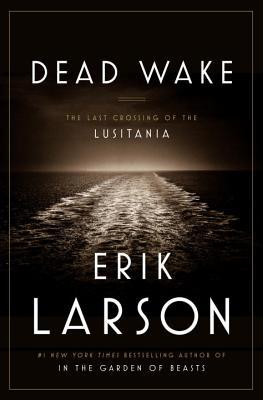Today I'm looking at a book titled Dead Wake which came out about a couple of years ago. As it says on the cover this book is about the sinking of the Lusitania in 1915 and I didn't know how interesting a read it would be so I left it on hold for a while. However, this book was part of an extensive advertising campaign on Smithsonian's website, and I kept seeing this book at the library and in bookstores so I broke down and decided that it was finally time to check this book out. The book goes into quite a lot of detail on a variety of subjects so I thought it was worth the effort.
As you might remember from high school history, the sinking of the Lusitania is one of the events that caused the United States to enter the First World War. If you know a little bit more about the event you might know that the Lusitania sunk within twenty minutes, which meant a significant number of passengers could not get to the lifeboats in time. There has been some debate among historians about why the Lusitania sank as quickly as it did. And the author does a really good job of explaining why preexisting theories were incorrect and providing evidence for his own theory.
First, a noticeable secondary explosion meant that many survivors, including the captain, assumed that the Lusitania was hit by two torpedoes from the attacking U-20. However U-20's logs and communications with German Navy command, as well as intercepts by British Intelligence, revealed that only one torpedo had been launched, which raised the question what caused the secondary explosion. Later disclosures of the manifest revealed that the Lusitania actually was carrying American-made ammunition for the British so it was believed that a cargo of munitions may have caused a secondary explosion. However the quantity of munitions loaded on the Lusitania were insufficient to cause a damaging explosion.
The explanation Larson provides lays in the structural design of the Lusitania itself. The Lusitania was originally part of a Royal Navy project to design large, fast ships and both the Lusitania and its sister ship the Mauritania were originally naval auxiliary ships. Although built and owned by Cunard lines, both the Lusitania and the Mauritania could be converted to cruisers in wartime. Although the navy decided to keep the Lusitania in civilian service, its military origins had significant effects on its design. Specifically the Lusitania had longitudinal coal bunkers. This meant that it had two large coal bunkers running along the entire length of the ship while most civilian ships had multiple small coal bunkers running across the beam of the ship. The idea behind this design was that the coal would serve as additional armor for the ship against enemy projectiles. Unfortunately, it appears longitudinal coal bunkers were actually a liability to ships hit by torpedoes. Because the watertight compartments within the coal bunkers weren't sealed, it basically provided a giant basin for water to enter the ship from a torpedo strike.
This explains why the Lusitania sank so quickly, especially considering the ship listed severely to the side on which it was struck, to the point it was difficult to get lifeboats launched from either side of the ship. As the water cascaded into the bowels of the ship, it is very likely the cold sea water caused some part of the steam machinery to explode. Larson points to a steam pipe, which may explain loss of control of the ship into the crisis, although a boiler or other apparatus is just as likely. The simplicity of the explanation as well as the evidence supporting this hypothesis provides a much better explanation for why the Lusitania may have sunk as quickly as it did.
Overall I think this book was well researched. Larson provides a lot of background detail which debunks the hypothesis that a secret cache of munitions on board caused the secondary explosion. As demonstrated with previous strikes on ships with longitudinal coal bunkers, a hit by a torpedo into the coal bunker caused the ship to sink in an astoundingly short period of time. It is probably safe to say the same occurred with the Lusitania.


No comments:
Post a Comment